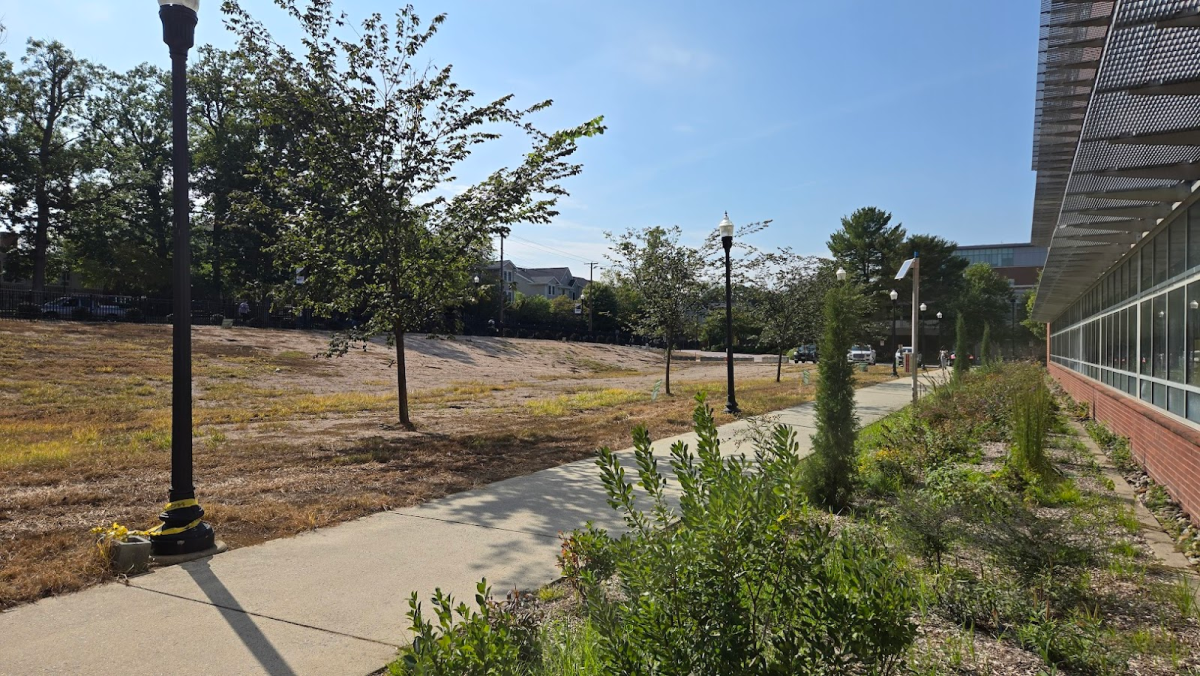
The garden and plain behind the science hall. (Aidan Vanhoof).
Behind the Science Hall is a swath of barren, almost deserted land. Grass isn’t growing; in fact, all that remains is hay. Dried-out foliage litters the exposed soil, in stark contrast with the perfectly manicured lawns everywhere else.
However, this dead landscape serves to create life.
Dr. Stephen Bentivenga, the department head of biological and biomedical sciences, and the department chair, Dr. Michael Grove, will work alongside landscapers, students, and organizations to fill this space with a “native plant meadow” over the next few years, according to a Rowan Announcer.
In the long run, the duo aims to replace parts of Rowan’s otherwise clean-cut campus with a more natural, less curated appearance.
“Let’s plant [on] things that used to be or currently are just lawn. Let’s turn it back into … [a] more native habitat,” Grove said.
This fits into a broader project called Homegrown National Park. The initiative stresses changing the way we landscape in ecological ways to promote biodiversity and healthy habitats. Unlike native plant life, grassy lawns, while they’re green, don’t emerge naturally, and constant maintenance with fertilizer, mowing, etc., hurts biodiversity. Few animal and insect species thrive, and many species of grass can be invasive, even damaging, to their surrounding environment.
“It’s essentially from an ecological perspective … a desert,” Grove said.
Grove specifically referenced some here at Rowan. To him, sprawling lawns represent untapped potential.
“We really want them to be native plants. Because of their coevolution with the native insect species, native bird species… they are so much stronger. They’ve had this long evolutionary history together.” Grove said.
Ideally, the introduction of plants native to South Jersey will bring in more native animals and insects. Pollinators, for example, are needed, as their populations continue to decline, in part due to the introduction of non-native species. This project aligns with Rowan’s ongoing goal to cultivate a more sustainable, ecologically friendly campus.
According to Dr. Bentivenga, we should see serious progress within the next few years.
“The native meadow will likely take several growing seasons to become established,” Bentivenga said over email.
The meadow will be arranged both for educational purposes and to be enjoyed as a place to study, teach, and explore.
“There’s a bunch of ways we could use this space,” Grove said.
They will set up clear spaces, plaques, and benches. Grove described a literature class teaching Shakespeare in a flower meadow with students studying or socializing at its center. The Rowan Announcer proposes “a living laboratory for students and visitors.” The project’s funding came from a grant. According to Grove, they’ve spent close to $3,500 and planted over 300 plants.
“It’s like there’s a bunch of ways we could use this space. I think somewhat for our classes. You know, if somebody wants to bring their literature class out here and read through Shakespeare or something,” Grove said.
Despite constant maintenance, weeds are an ongoing problem. Currently, the meadow is just a small sliver of garden up against the Science Hall; much of it is nut grass and crab grass, but blooming flowers and bushes draw attention away from the weeds. He went on to describe how some clubs and organizations may contribute to weeding, planting, and maintenance efforts.
“It was a bunch of student help … There was definitely student help because we had reached out to the clubs,” Grove said.
Beyond the Science Hall, biodiversity efforts are dispersed across campus. By the softball field, a meadow, which neither Bentavenga nor Grove knew about, has been established, featuring signs warning against mowing. The bridge used to enter Robinson Hall crosses a stream surrounded by thick, green plant-life. The biodiversity found there is new and deliberate.
“If you look at their strips in the parking lots, they’re actually pretty densely planted. Actually, some of the stuff on the other side of Robinson, right where that bridge is … all that stuff has been put in the last, I want to say, 5 years,” Grove said.
Referring to the project behind the Science Hall, students say, while its current state isn’t pretty, the result makes it worth it.
“I would say in its current state, this is ugly. [But] they’re actively working towards making it a nice spot for the campus, so I’m fine with it being in its very clear growing stage,” said senior music technology major Matthew Farmer.
While this bald spot on an otherwise lively campus may not be pretty, it will grow into something substantial and beautiful, contributing to an overall more ecologically friendly and diverse campus experience.
For comments/questions about this story, DM us on Instagram @thewhitatrowan or email [email protected]